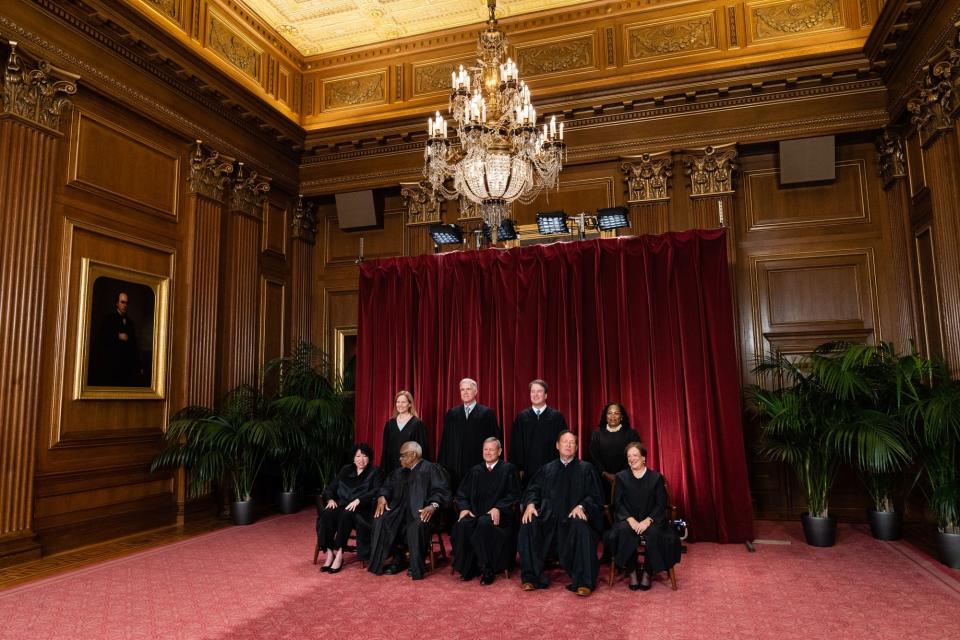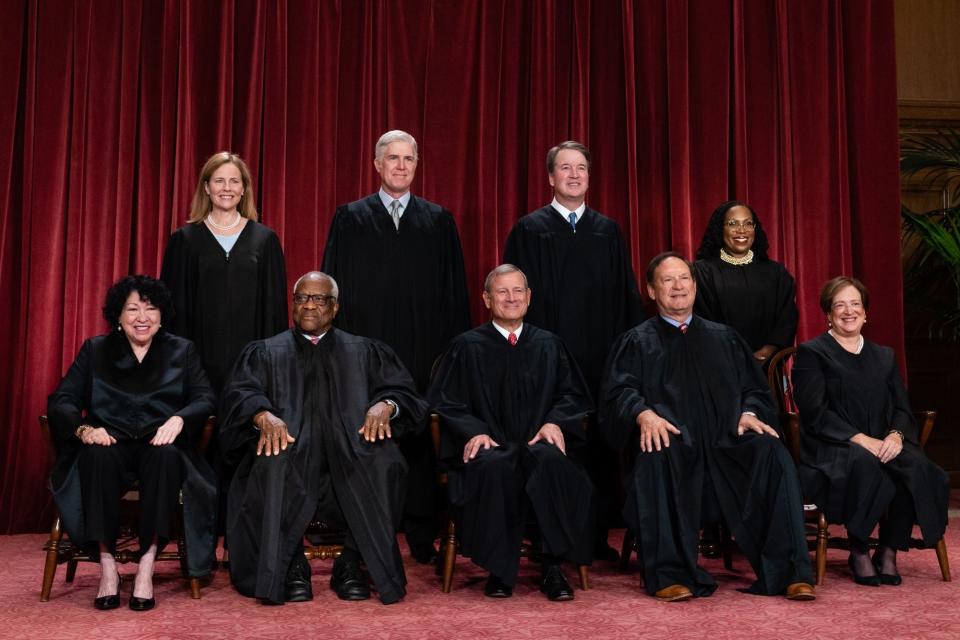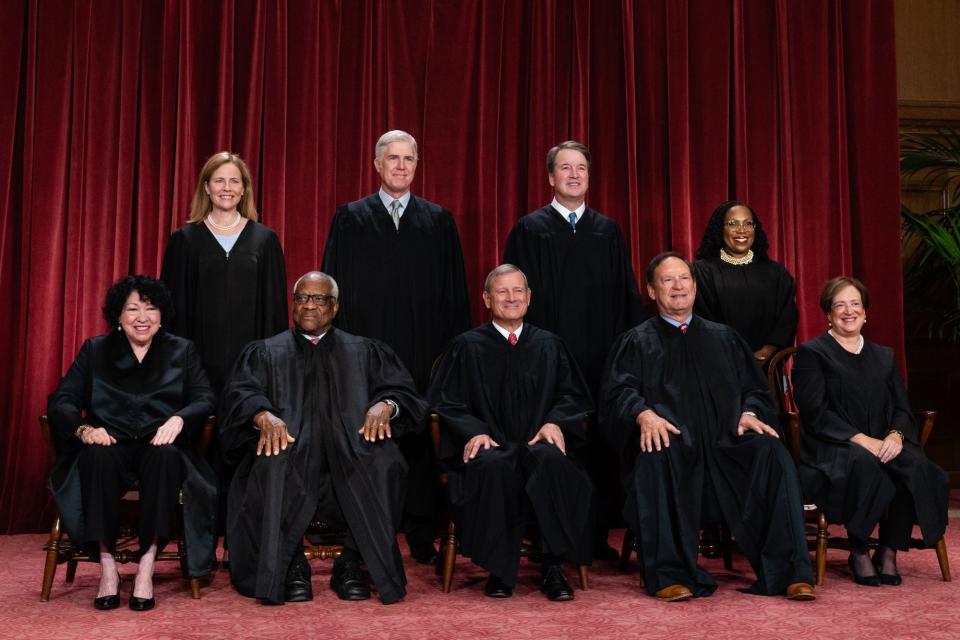Conservatives on Supreme Court Seek End to Affirmative Action in College Admissions
(Bloomberg) -- The US Supreme Court’s conservative majority suggested a readiness to abolish the use of race in university admissions, casting doubt on policies supporters say are essential for ensuring diverse student bodies at the nation’s most selective institutions.
Most Read from Bloomberg
Chief Justice Temporarily Stops Release of Trump Tax Returns
Lottery Winner Keeps $30 Million Jackpot Secret From Wife and Child
Democrats Prepare for Loss of Congress as Voters Break Late to GOP
China Markets Rally After Unconfirmed Social Posts on Reopening
Hearing almost five hours of arguments in Washington on Monday, the justices showed deep divides -- largely, if not completely, along ideological lines -- as they heard challenges to affirmative action programs at the University of North Carolina and Harvard College.
Several of the conservatives suggested they saw affirmative action, which the court first upheld in 1978, as having run its course. They said the Supreme Court never envisioned race-conscious admissions would last forever, and they repeatedly pressed defenders to lay out an end point for the programs.
“What are you saying when you’re up here in 2040?” Justice Amy Coney Barrett asked North Carolina Solicitor General Ryan Park. “Are you still defending it, like this is just indefinite, it’s going to keep going on?”
Affirmative action now is common at selective universities, though nine states including California and Florida ban race-conscious admissions at public institutions. A ruling outlawing the practice could mean fewer Black and Hispanic students at many of the top universities -- a point the court’s outnumbered liberals tried to drive home as they focused on the impact across society.
“In your view, it really wouldn’t matter if there was a precipitous decline in minority admissions -- African American, Hispanic, one or the other,” Justice Elena Kagan said. She described universities as the “pipelines to leadership in our society.”
But the court’s conservatives suggested they were more interested in finding an end date for what some of them cast as racial discrimination in violation of the Constitution’s equal protection clause.
Oboe Players
Chief Justice John Roberts bristled when Harvard’s lawyer, Seth Waxman, likened the consideration of race to a preference given to an oboe player in a year when the college orchestra was in need of another musician.
“We did not fight a civil war about oboe players,” Roberts said. “We did fight a civil war to eliminate racial discrimination, and that’s why it’s a matter of considerable concern.”
The court is likely to rule by June in the cases, potentially making the current university admissions cycle the last one with affirmative action.
Racial-preference opponents are seeking to overturn the court’s 2003 Grutter v. Bollinger decision, which reaffirmed that universities can consider race in admissions to bolster campus diversity.
Justice Clarence Thomas made clear he viewed diversity as too amorphous a concept to warrant letting schools make racial distinctions.
“I’ve heard the word diversity quite a few times, and I don’t have a clue what it means,” Thomas said. “It seems to mean everything for everyone.””
When Park argued that diversity had educational benefits, Thomas said he didn’t “put much stock in that because I’ve heard similar arguments in favor of segregation, too.”
Justice Ketanji Brown Jackson, the court’s newest member and its first Black woman, questioned the idea that universities were giving sweeping racial preferences. She said North Carolina considered race only when individual students say in their applications that it’s is an important part of who they are.
“This is not a situation in which the university is asking or telling every applicant, ‘Give us your race, so that we can classify people, so that we can give certain people preferences,’” Jackson said. “The only reason why the university knows the race of any of these applicants is because they are voluntarily providing that.”
Jackson is taking part only in the North Carolina case, having recused herself from the Harvard fight after a six-year term on that university’s Board of Overseers.
Racial-preference opponents are trying to take advantage of a court that has become more conservative since the 2003 Grutter decision. The universities are fighting lawsuits by Students for Fair Admissions, an anti-preferences organization that says its members include unsuccessful applicants to both schools. The group is run by former stockbroker Edward Blum.
End Point
Even in the 2003 case, the court suggested that affirmative action’s days were numbered. Writing the majority opinion Justice Sandra Day O’Connor said, “We expect that 25 years from now, the use of racial preferences will no longer be necessary.”
The conservative wing repeatedly pointed to that passage Monday. “Grutter doesn’t say, ‘This is great, we embrace this,” Barrett said. “Grutter says, ‘This is dangerous, and it has to have an endpoint.’”
Justice Brett Kavanaugh told another lawyer backing the North Carolina policy that “you would extend it far beyond 25 years, indefinitely.”
Patrick Strawbridge, a lawyer representing Students for Fair Admissions, said abolishing race-conscious admissions wouldn’t preclude universities from considering a student’s experience overcoming racism. And he said universities could still making diversity a goal as long if used race-neutral means to pursuit it.
Justice Neil Gorsuch, another conservative, suggested universities might be able improve diversity by eliminating preferences given to athletes and the children of alumni and big-money donors.
“Is there compelling interest in a squash team composed of really good players or a new art museum?” he asked Park, the North Carolina lawyer.
But liberal Justice Sonia Sotomayor, who has described herself as an affirmative action beneficiary, said the trial judge in the North Carolina case found that race-neutral methods proposed by the challengers would mean a reduction in diversity.
“I looked at all of your simulations, every one of them,” Sotomayor said. “So did the district court. And in every one of them, white representation stayed the same or went up. And some minority groups increased, but others did not. Blacks decreased in every one of your simulations.”
As a private institution, Harvard isn’t bound by the equal protection clause, which applies only to government actors. The suit against Harvard involves the Civil Rights Act’s Title VI, which covers recipients of federal funds and bars discrimination “on the basis of race, color or national origin.”
The North Carolina lawsuit invokes Title VI as well as the Constitution’s equal protection clause. The Supreme Court in 1978 said the two provisions imposed similar legal requirements on universities.
The cases are Students for Fair Admissions v. President and Fellows of Harvard College, 20-1199, and Students for Fair Admissions v. University of North Carolina, 21-707.
--With assistance from Zoe Tillman and Jordan Rubin.
(Adds description of Title VI at end of story.)
Most Read from Bloomberg Businessweek
Yeezy Roller Coaster Ended With Two-Minute Phone Call at Adidas
These Five Women Are Helping Doctors Crack the Long-Covid Mystery
Can an Election-Denial Alliance Save Republican Senate Hopes in Arizona?
Basketball’s Top Shrink on How Finding Purpose Lifts Performance
©2022 Bloomberg L.P.





